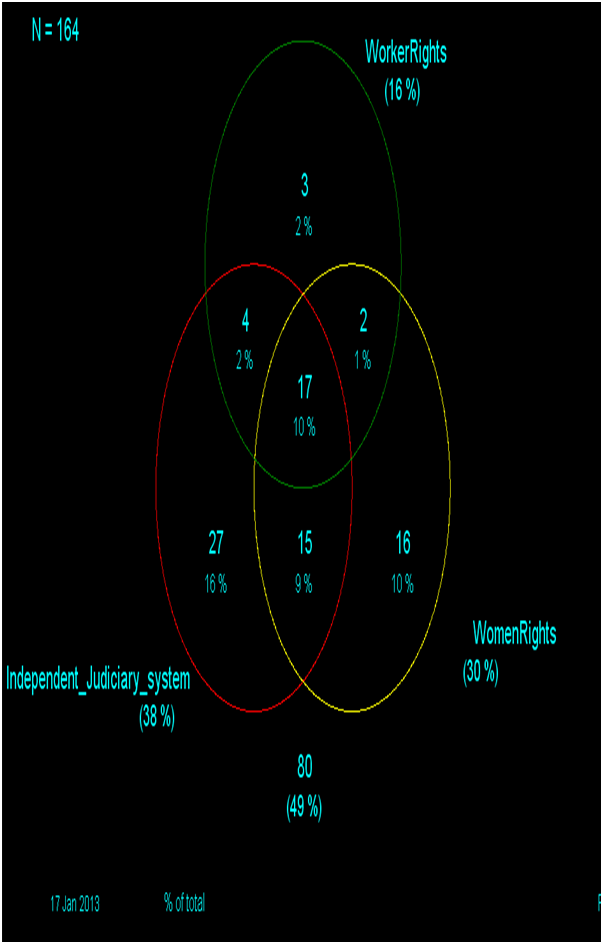TUNESS Chart of the Week (TCW), Friday Jan 18, 2013
Few will argue today with the idea that one of the main aspirations of the Tunisian young population when they marched on the street during the revolution was to demand equal rights for all and fight the discrimination against the most fragile and marginalized classes. Women and workers have always been among those classes. Today two years have passed, and despite this unequivocal call for the consolidation of the rights of those groups, minor improvements were made in this area. Why? Simply because we have been struggling to build a new house with little attention, if any, paid to the robustness of its pillars.
 Like any other society, an independent judiciary system, that’s fair and impartial courts, will always be the ultimate pillar and guardian of the house of rights. Using the Venn diagram, we looked at the state of the judiciary system, women and workers rights in more than 160 countries around the world. We found that the insulation of justice courts from external influence (either the executive branch or private interests) doesn’t not appear to systematically guarantee women and workers rights (for instance, according to our study, 27 countries have ensured both decisional and structural independence of their justice system without necessarily fully respecting the rights of all classes of the societies (captured by the yellow circle for Women rights and green circle for the workers’ rights). To state the obvious, the main reason of this empirical finding is the lack of the political will of the government in place to enforce and to comply with the courts‘ decisions. The striking take away message of this chart is that, in almost all countries where the independence of the judicial systems is not respected (80 countries representing the area outside the red circle), the rights of the most fragile classes of the societies are found to be constantly violated. Conversely, only in exceptional cases (2 countries), we were able to find that both rights are enforced despite the absence of independent courts of justice, which provides yet an additional support to our conclusion above that an independent justice that does not yield to political pressure and intimidation remain the condicio sine qua non to protect the rights of the powerless.
Like any other society, an independent judiciary system, that’s fair and impartial courts, will always be the ultimate pillar and guardian of the house of rights. Using the Venn diagram, we looked at the state of the judiciary system, women and workers rights in more than 160 countries around the world. We found that the insulation of justice courts from external influence (either the executive branch or private interests) doesn’t not appear to systematically guarantee women and workers rights (for instance, according to our study, 27 countries have ensured both decisional and structural independence of their justice system without necessarily fully respecting the rights of all classes of the societies (captured by the yellow circle for Women rights and green circle for the workers’ rights). To state the obvious, the main reason of this empirical finding is the lack of the political will of the government in place to enforce and to comply with the courts‘ decisions. The striking take away message of this chart is that, in almost all countries where the independence of the judicial systems is not respected (80 countries representing the area outside the red circle), the rights of the most fragile classes of the societies are found to be constantly violated. Conversely, only in exceptional cases (2 countries), we were able to find that both rights are enforced despite the absence of independent courts of justice, which provides yet an additional support to our conclusion above that an independent justice that does not yield to political pressure and intimidation remain the condicio sine qua non to protect the rights of the powerless.
(Chart prepared by TUNESS Research Team)
Data source:Cingranelli and Richards (2010), Human Rights Dataset.
